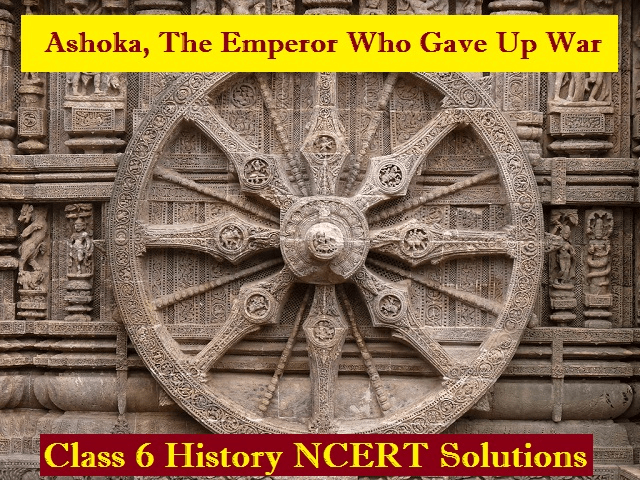NCERT Solutions for Class 6 History - From a Kingdom to an Empire
| Table of contents |

|
| Let’s Recall |

|
| Let’s Discuss |

|
| Let's Do |

|
| Keywords |

|

Let’s Recall
Q1. Make a list of the occupations of the people who lived within the Mauryan empire.
Ans: List of the occupations of the people who lived within the Mauryan empire:
- Farming
- Herding
- Handicrafts
- Trading
- Hunting-gathering
Q2. Complete the following sentences:
(a) Officials collected _____ from the area under the direct control of the ruler.
Ans: tax
(b) Royal princes often went to the provinces as ____
Ans: governors
(c) The Mauryan rulers tried to control ____ and ____ which were important for transport.
Ans: roads and rivers
(d) People in forested regions provided the Mauryan officials with ____
Ans: elephant, timbers, honey and wax.
Q3. State whether true or false:
(a) Ujjain was the gateway to the north-west.
Ans: False
The Mauryan province of Taxila was the gateway to the north-west.
(b) Chandragupta’s ideas were written down in the Arthashastra.
Ans: False
Arthashashtra is Sanskrit which means economic science. The Ideas of Kautilya, known as Chanakya, were written down in Arthashashtra.
(c) Kalinga was the ancient name of Bengal.
Ans: False
Kalinga refers to the coastal region between the Godavari and Mahanadi rivers, in what is modern-day Orissa, not Bengal.
(d) Most Ashokan inscriptions are in the Brahmi script.
Ans: True
Brahmi Script is the parent language of Hindi and many other north Indian languages. Ashokan inscriptions were written in Brahmi script.
Let’s Discuss
Q4. What were the problems that Ashoka wanted to solve by introducing dhamma?
Ans: The problems that Ashoka wanted to solve by introducing dhamma were:
- Inter-religious conflicts between his subjects.
- Animal sacrifice during religious rituals.
- Ill-treatment of servants and slaves.
- Constant disputes between neighbours over petty issues.
Q5. What were the means adopted by Ashoka to spread the message of dhamma?
Ans: The means that Ashoka adopted to spread the message of dhamma were:
- He appointed officials, known as the dhamma mahamatta who went from place to place teaching people about dhamma.
- He got his messages inscribed on rocks and pillars, instructing his officials to read his message to those who could not read it themselves.
- He also sent messengers to spread ideas about dhamma to other lands, such as Syria, Egypt, Greece and Sri Lanka.
Q6. Why do you think slaves and servants were ill-treated? Do you think the orders of the emperor would have improved their condition? Give reasons for your answer.
Ans: Slaves and servants were ill-treated owing to the following reasons:
- Most of them were prisoners of war.
- Some belonged to the lowest social order, specifically Shudras.
- The concept of human rights was virtually non-existent during that period.
Their condition would have improved after the order of the Emperor because:
- No one would dare defy the supreme order of the emperor himself.
- Those who would disobey the emperor would be severely punished by his officials.
- The Emperor was the supreme commander of the Mauryan Empire. Thus his word was law and had to be obeyed to the fullest extent.
Let's Do
Q7. Write a short paragraph explaining to Roshan why the lions are shown on our currency notes. List at least one other object on which you see them.
Ans: The Ashoka pillar in Sarnath has four lions on top. After Buddha became enlightened, he gave his first sermon in Sarnath. The four lions represent Buddhism and stand for peace and friendship. During India's fight for freedom, Buddhist ideas of non-violence inspired the movement. The lions in our national symbol represent truth, peace, and friendship. This symbol is used by all government departments and can also be seen on our passports.
Q8. Suppose you had the power to inscribe your orders, what four commands would you like to issue?
Ans: Students should do this project on their own
Keywords
- Empire: A large group of territories and people, ruled by a single leader or government.
- Capital: The main city or town of a country, usually where the government is located.
- Province: A region or administrative division within a country, smaller than the whole country.
- Dhamma: In Buddhism, it refers to the teachings and principles that guide one's conduct and lead to a righteous way of life.
- Messenger: Someone who carries and delivers messages or information from one person to another.
- Official: A person holding a position of authority in an organization, government, or group, responsible for making decisions or enforcing rules.
|
297 videos|1065 docs|204 tests
|
FAQs on NCERT Solutions for Class 6 History - From a Kingdom to an Empire
| 1. What were the main reasons for the transition from a kingdom to an empire in ancient times? |  |
| 2. How did the Maurya Empire exemplify the idea of an empire in ancient India? |  |
| 3. What role did trade play in the growth of ancient empires? |  |
| 4. How did the concept of governance change from kingdoms to empires? |  |
| 5. What were the cultural impacts of empires on their territories? |  |





















